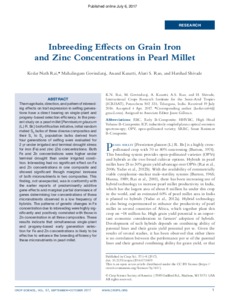Inbreeding Effects on Grain Iron and Zinc Concentrations in Pearl Millet
Abstract
The magnitude, direction, and pattern of inbreeding effects on trait expression in selfing generations have a direct bearing on single-plant and progeny-based selection efficiency. In the present study on a pearl millet (Pennisetum glaucum (L.) R. Br.) biofortification initiative, initial random mated S0 bulks of three diverse composites and their S1 to S4 population bulks derived from four generations of selfing were evaluated for 2 yr under irrigated and terminal drought stress for iron (Fe) and zinc (Zn) concentrations. Both Fe and Zn concentrations were higher under terminal drought than under irrigated condition. Inbreeding had no significant effect on Fe and Zn concentrations in one composite and showed significant though marginal increase of both micronutrients in two composites. This finding, not unexpected, was in conformity with the earlier reports of predominantly additive gene effects and marginal partial dominance of genes determining low concentrations of these micronutrients observed in a low frequency of hybrids. The patterns of genetic changes in Fe concentration due to inbreeding were highly significantly and positively correlated with those in Zn concentration in all three composites. These results indicate that simultaneous single-plant and progeny-based early generation selection for Fe and Zn concentrations is likely to be effective to enhance the breeding efficiency for these micronutrients in pearl millet

